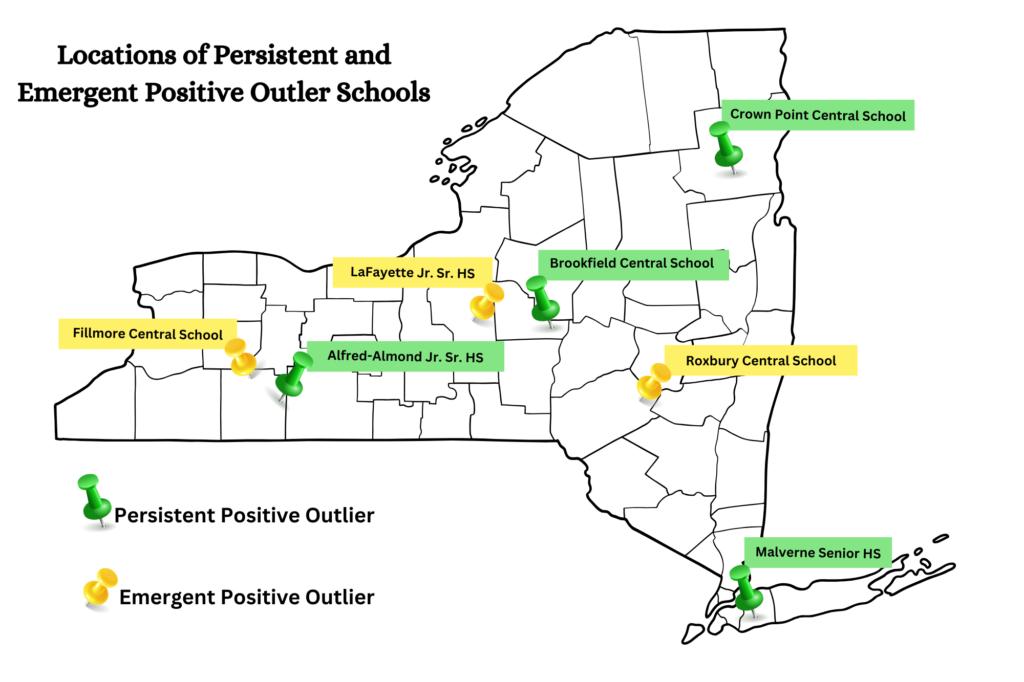How Do We Identify Persistent and Emergent Positive Outlier Schools and Study Them?: Methods and Procedures Report for NYKids’ Latest Study Now Available
by Aaron Leo, Kristen C. Wilcox, and Paul Guay
After a year of hard work, our latest study, “NYKids’ 20th Anniversary Study of Emergent and Persistent Positive Outlier Schools: What Accounts for Better Student Outcomes Over Time?” is on its way! The full report findings will be ready in November, but for now, we are announcing the release of the Methods and Procedures Report which details the study sampling, data collection, and data analysis methods used for this research.
Study Background
In our 20th year, NYKids decided to conduct a unique study. This year we explored two groups of schools:
The first group of schools is Persistent Positive Outlier Schools (POs). These are schools previously identified as positive outliers in NYKids studies and have continued to exhibit above-predicted graduation rates
The second group is Emergent Positive Outlier Schools (EOs). These are schools which were previously identified as typically-performing yet have risen to positive outlier status.
Our study was centered around one overarching research question:
What accounts for persistent and emergent positive outlier schools’ comparatively better outcomes for culturally, linguistically, and socio-economically diverse youth?
Considering the most pressing issues facing educators throughout New York State, we focused the study around several lines of inquiry:
- District and school leadership
- Educator recruitment and retention
- Student; parent, caregiver and community engagement
- Culturally-responsive and technology-enhanced curriculum and instruction
- Data generation and utilization systems.
Sample Selection and Recruitment
How did we find out which schools were POs and EOs? With the help of Professor Kim Colvin, our team performed a series of regression analyses to identify which schools previously studied by NYKids outperformed on their graduation rate in the 2021-22 school year over what would be expected based on demographic information. “Outperforming” was determined by computing the residual from regression analyses for a subgroup of students. A positive residual indicated that the school performed better than predicted given the included variables and a negative residual indicated the school performed worse. We then used a standardized z-score calculated from the residuals to identify higher performing schools for recruitment.

We ended up with a total of 11 schools that qualified as either persistent or emergent POs and seven agreed to participate in the study:
1) Alfred-Almond Junior-Senior High School
2) Brookfield Central School
3) Crown Point Central School
4) Malverne Senior High School
5) Fillmore Central School
6) LaFayette Junior-Senior High School
7) Roxbury Central School

Once persistent and emergent positive outlier schools were identified, our team reached out to school and district leaders to inform them about the research project. Those who agreed to participate then helped recruit teachers and other staff to participate in interviews or focus groups. Parents/caregivers were recruited via a flyer distributed by the school liaison via school mail or email.
Our team then conducted site visits at each school. During these visits our team conducted interviews and focus groups with leaders, teachers, staff members, and family members. We also collected documents from each school and participated in school tours.
In total, we interviewed 182 participants across these seven positive outlier schools!
Data Analysis
All interviews and focus groups were recorded, transcribed, and then coded using qualitative research software called NVivo. This software program provides researchers with a helpful way to organize data along the original lines of inquiry which guided the study while also developing new and emerging themes and findings which develop during the analysis process.
Then, individual case studies of each school were crafted – all of which are available on our website.
Finally, our team met – along with graduate assistants who accompanied our team on site visits – to begin assembling the cross-case report. As a preview to the final report which will be released in November, we found that educators in the persistent positive outliers focus on…

1) Building and Rebuilding Positive Relationships
2) Enhancing Competency-based and Affinity-based Curriculum and Instruction
3) Flattening, Steadying, and Stabilizing Leadership
4) Structuring Components of a Learning Organization into the Fabric of the School
Stay tuned as the full report will be available on our website soon! Please follow us on X, Instagram, Facebook, and LinkedIn. Reach out to us with questions or comments by email at nykids@albany.edu.
